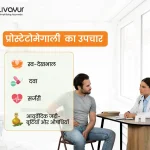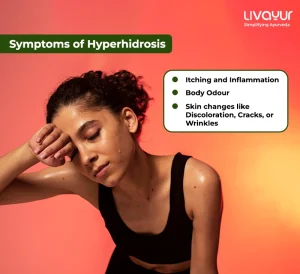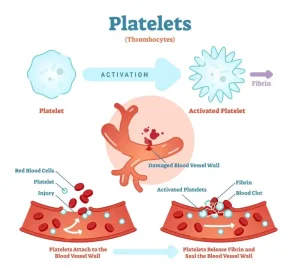This article is reviewed Dr. Shankar Rao

Cervical spondylosis, also known as cervical osteoarthritis or arthritis of the neck, is a condition that affects the neck region of the spine. It is characterized by the degeneration of the bones, discs, and joints in the cervical spine (the upper part of the spine comprising the neck). The condition causes neck pain and stiffness, affecting most aged adults. This is regarded as a natural part of the aging process and has a prevalence rate of 95 percent by age 65 [1].
Cervical Spondylosis Symptoms
The main symptoms of cervical spondylosis can vary from person to person, and some individuals may not experience any symptoms at all. However, common cervical spondylosis symptoms include [2]:
- Persistent or intermittent pain in the neck that may be localized or may radiate to the shoulders, arms, or even the fingers. The severity of pain can also vary greatly and may worsen with certain movements or activities.
- A feeling of tightness or reduced range of motion in the neck is also common and it may become difficult to turn the head or move the neck freely.
- Cervical spondylosis can cause headaches, particularly at the back of the head (occipital headaches) or at the base of the skull.
- Some individuals may experience numbness, tingling, or a “pins and needles” sensation in the shoulders, arms, hands, or fingers. This occurs due to the compression of nerves in the cervical spine.
- Muscular weakness in the arms or hands may occur, leading to difficulties in gripping objects, performing fine motor tasks, or experiencing a sense of clumsiness.
- In some cases, cervical spondylosis can affect coordination and balance, leading to unsteadiness while walking or performing activities that require precise movements.
- The muscles in the neck and upper back may undergo involuntary contractions or spasms, resulting in pain and stiffness.
- In advanced cases where there is compression of the spinal cord, individuals may experience a loss of sensation or altered sensation in various parts of the body.
Cervical Spondylosis Causes
Cervical spondylosis is primarily caused by age-related changes in the spine, but there are several factors that contribute to its development. The main cervical spondylosis causes include [3]:
Age: The natural aging process leads to degeneration of the spinal discs and joints. As we grow older, the discs lose moisture and become less flexible, while the joints may develop osteoarthritis. These changes increase the likelihood of cervical spondylosis.
Wear And Tear: Repetitive stress and strain on the cervical spine, which can occur due to occupations involving heavy lifting, constant neck movements, or poor posture, can accelerate the degenerative changes in the spine.
Spinal Injuries: Prior neck injuries, such as fractures or dislocations, can contribute to the development of cervical spondylosis.
Additionally, some individuals may have a genetic predisposition to cervical spondylosis and smoking and obesity can also increase the risk of spinal disc degeneration.
Cervical Spondylosis Diagnosis
Cervical spondylosis is typically diagnosed through a combination of physical examination, medical history review, and diagnostic imaging tests [4].
Medical History And Physical Examination: Your healthcare provider will begin by discussing your symptoms, their duration and your medical history. Your doctor will also assess your neck mobility, muscle strength, reflexes and sensation to identify any abnormalities.
Imaging tests: X-rays, MRIs and CT scans can be used to detect any degenerative changes, including the growth of bone spurs, misalignment, herniated discs, spinal cord compression, and nerve root impingement.
In certain cases, additional tests may be ordered to evaluate nerve function or rule out other conditions that may present with similar symptoms. These tests can include electromyography (EMG) to assess nerve and muscle function, nerve conduction studies (NCS) to measure the speed of nerve signals, or blood tests to rule out specific underlying causes of symptoms.
Cervical Spondylosis Treatment

The approach to managing cervical spondylosis depends on the severity of symptoms and their impact on daily life. The main cervical spondylosis treatments include [1]:
Conservative Measures
These include rest, avoiding activities that worsen symptoms, maintaining good posture, and using neck braces or collars to provide support and relieve strain on the neck.
Physical Therapy
Specific exercises and stretching techniques can help improve neck strength, flexibility, and posture. Physical therapy may also involve modalities such as heat or cold therapy, ultrasound, or electrical stimulation.
Pain Management
Over-the-counter pain relievers such as nonsteroidal anti-inflammatory drugs (NSAIDs) may be recommended to alleviate pain and reduce inflammation. In some cases, prescription medications or muscle relaxants may be prescribed for more severe pain or muscle spasms.
Steroid Injections
Corticosteroid injections into the affected area may provide temporary relief by reducing inflammation and relieving pain. These injections are typically administered under guidance using imaging techniques.
Surgical Intervention
Surgery is usually considered as a last resort when conservative treatments fail to provide relief or in cases of severe compression of the spinal cord or nerve roots. Surgical procedures may involve removing the herniated or damaged discs, fusing adjacent vertebrae, or decompressing the spinal cord or nerve roots.
Ayurvedic Treatment
Natural therapies like Ayurveda are often preferred to avoid the side effects and risks associated with NSAIDs, corticosteroids, and surgery. Ayurvedic cervical spondylosis treatment includes oral supplements containing herbs like Guggulu, topical application of Panchguna tail, and therapies like Nadi Sweda [5].
Cervical Spondylosis Risk Factors
The primary cause of cervical spondylosis is degeneration that comes with aging (the normal wear and strain on the spinal cord’s bones). The following are some potential reasons for cervical pain:
- Osteophytes, often known as bone spurs or abnormal outgrowths of bones: The body grows new and additional bones to strengthen the spine as it ages degenerates and gets weaker. Bone spurs are the term for this abnormal production of bones or cervical osteophytes.
- Athletics: Significant spinal trauma, a congenitally narrow vertebral canal, dystonic cerebral palsy affecting the cervical musculature, and certain sports like rugby, soccer, and horseback riding can all cause an accelerated disease process and early-onset cervical spondylosis.
- Compression of the spinal cord: Compression of the spinal cord, spinal vasculature, and nerve roots can lead to cervical spondylosis and result in axial neck discomfort, cervical myelopathy, and cervical radiculopathy.
Many studies have shown that age, gender, and occupation are the only risk factors for cervical spondylosis. (6)
When to See a Doctor
Get in touch with a healthcare professional if:
- The symptoms become worse in a short amount of time
- There are indications of difficulties
- You start experiencing new symptoms, such as a lack of sensation or movement in a certain part of your body
- You lose control of your bowels or bladder
Home Remedies for Cervical Spondylosis I Ayurvedic Remedies for Cervical Spondylosis
Cervical spondylosis is treated with ayurvedic massage techniques such as abhyanga (oil massage), pizhichil (oil bath), and Shirodhara (oil applied to the forehead) at Greeva Basti, Pichu. These massages can lessen stiffness and soreness in the neck and increase blood circulation.
Conclusion
The appropriate treatment plan will depend on individual factors, so it’s important to consult with an experienced and qualified Ayurvedic doctor, who can evaluate your specific condition and recommend the most suitable treatment options for you.
FAQs
Is cervical spondylosis curable?
As the condition is part of the natural aging process it cannot be cured or reversed. However, early diagnosis and treatment can prevent its progression.
Can cervical spondylosis affect vision?
Yes, due to compression of nerves, cervical spondylosis can cause blurring of vision or complete vision loss in some individuals.
Does cervical spondylosis affect mental health?
Due to the chronic pain, people with cervical spondylosis are more vulnerable to depressive disorders. Recent research also indicates that the condition can cause memory loss and impaired attention.
Is cervical spondylosis life-threatening?
Cervical spondylosis is usually not life-threatening, but if left untreated it can ultimately cause permanent nerve damage, resulting in paralysis or death.
Disclaimer: The information provided here is for general information and not meant to substitute any medical advice. Please consult your doctor for appropriate medical consultation.
References:
- https://www.ncbi.nlm.nih.gov/books/NBK551557/
- https://www.ncbi.nlm.nih.gov/pmc/articles/PMC1819511/
- https://medlineplus.gov/ency/article/000436.htm
- https://www.mayoclinic.org/diseases-conditions/cervical-spondylosis/diagnosis-treatment/drc-20370792
- https://www.ncbi.nlm.nih.gov/pmc/articles/PMC3215367/
- https://www.ncbi.nlm.nih.gov/pmc/articles/PMC4264061/
- https://www.ncbi.nlm.nih.gov/books/NBK551557/

























